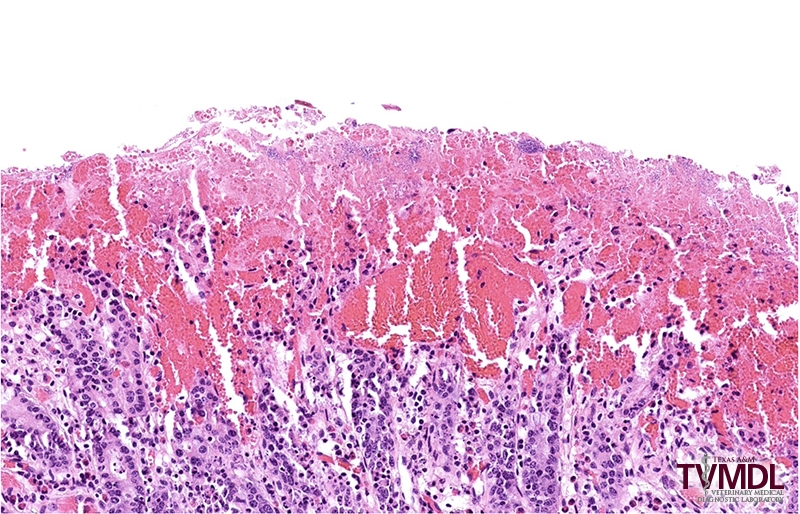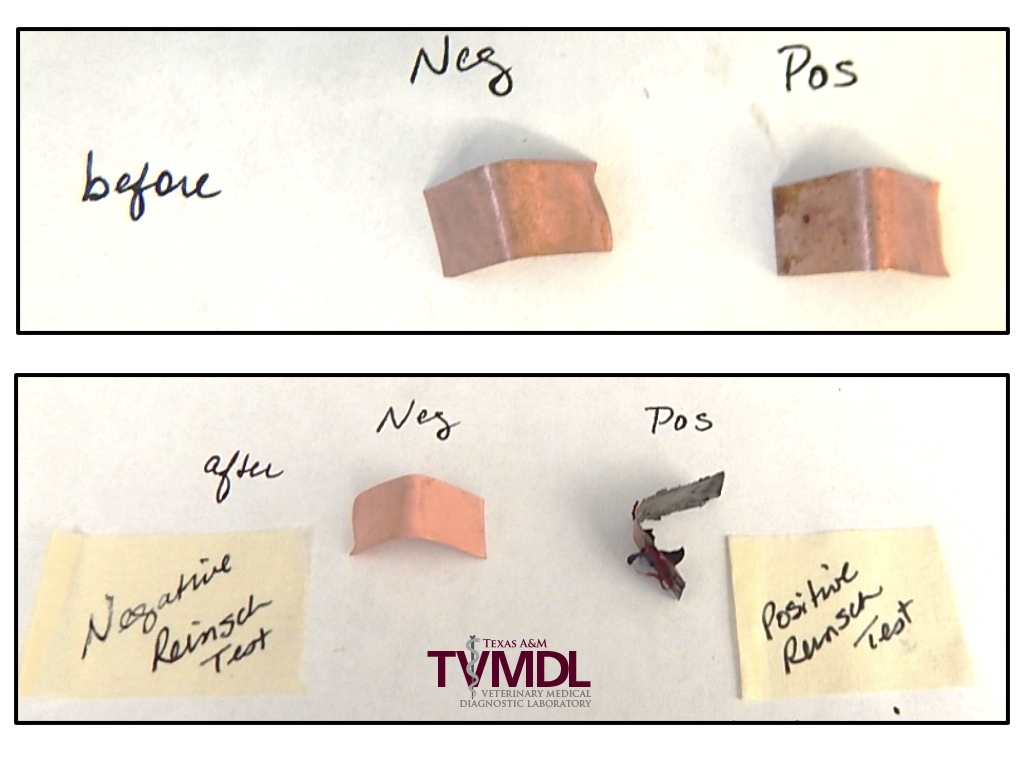Arsenic toxicosis in two calves
By Randi Gold, VMD, PhD, DACVP and Cat Barr, PhD, DABT
Two hundred and forty straight stocker cattle were on a wheat and grass pasture with access to old barns filled with moldy hay, chemicals, fertilizers, and other substances. Six percent of the animals reportedly died within a 24-hour period. Two 7-month-old calves were necropsied on site and were noted to have melting abdominal fat, hemorrhage inside the cardiac wall (endocardium) and bloody diarrhea. Multiple samples of fixed and fresh tissue were submitted to the Texas A&M Veterinary Medical Diagnostic Laboratory (TVMDL) in College Station for testing.
Histopathology revealed a marked and diffusely ulcerated and necrotizing abomasitis with an overlying serocellular crust composed of hemorrhage, serum protein, fibrin, and basophilic bacteria in both calves (Figure 1). The hearts had varying degrees of hemorrhage and myocyte degeneration. Both calves had numerous myocardial sarcocysts. The remaining organs were relatively unremarkable.
Toxicology testing determined the ocular fluid was negative for nitrate/nitrite and the rumen content did not contain detectable organic pesticides by GC/MS. A metal & mineral panel performed on the liver found an arsenic concentration of 109.74 µg/g on a dry weight basis. Bovine liver arsenic concentrations are normally below 2 µg/g dry weight, and concentrations over 8 µg/g dry weight are present in cases of acute arsenic poisoning. A Reinsch test of the rumen content indicated the source was an inorganic arsenic compound (a salt, probably an old pesticide formulation) rather than an organic source (monosodium – or disodium – methyl arsenate [MSMA or DSMA] herbicide), which fit the gross necropsy findings described (Figure 2). Metallic arsenic causes damage to the abomasal mucosa as it is acidified and absorbed into the blood.
Arsenic poisoning can be acute and chronic and often results in few to no lesions on post-mortem evaluation. The most common source of arsenic poisoning in large animals is ingestion or absorption of the salts or fluids containing arsenic that have been sprayed on forages for insecticides and herbicides. In acute poisoning, most lesions result due to the vascular injury caused by the compound. This manifests as petechial hemorrhage of serous membranes that can progress to ulceration, often seen first in the abomasum of bovids. Clinical signs often follow 1-2 days after ingestion with acute abdominal distress, nervous depression, terminal diarrhea, and convulsions. Ingestion of very large amounts of inorganic arsenical can result in death in <24 hours due to peripheral circulatory collapse. In chronic poisoning the signs are often non-specific. Animals may appear unthrifty with a loss of vigor and variable appetite. On histology the abomasum remains congested, edematous, and ulcerated but more prominent fatty changes are noted in the heart, liver, and kidney.
References:
– Cantile, C., Youssef, S. (2016). Nervous system. In M.G. Maxie (Ed.), Jubb, Kennedy and Palmer’s pathology of domestic animals (6th ed., p. 327). St. Louis, MO: Elsevier.

